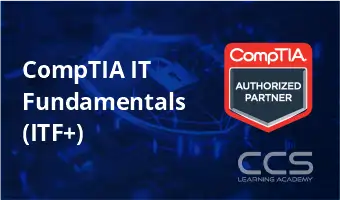Filter by Topic
Filter by Vendor
CompTIA IT Fundamentals (ITF+)
Course Description This course will prepare participants to take the …
What you'll learn
Set up a computer workstation and use basic software applications.
Explain the functions and types of devices used within a computer system.
Apply basic computer maintenance and support principles.
Describe some principles of software and database development.
Configure computers and mobile devices to connect to home networks and to the Internet.
Identify security issues affecting the use of computers and networks.
PMP – Project Management Professional
Course Description Project Management Professional (PMP)® Certification is fast becoming …
What you'll learn
To understand the various project components in detail and learn how to effectively integrate them to ensure successful project outcomes
To acquire resource management skills
To learn how to apply the Work Breakdown Structure (WBS)
To know how to uncover the risks associated with a project
To demonstrate project execution and project control techniques required for project success
To carry out project closure activities on time and get formal sign-off on projects
Prepare to take the PMP exam
Become familiar with PMBOK® Guide terms, definitions, and processes
Master test-taking techniques
Learn styles and types of questions found on the PMP exam
PMBOK® Guide’s five process groups, ten knowledge areas, and the area of professional and social responsibility
PMI Agile Certified Practitioner (PMI-ACP) Certification
Course Description Project managers’ use of Agile has risen, increasing …
What you'll learn
Use Agile practices in their projects,
Work in organizations adopting or are planning to adopt Agile for project management
Want to demonstrate a level of proficiency in Agile project management practices
Want to increase their professional versatility in both Waterfall and Agile techniques
Want to have Agile certification
Data Warehouse (OLAP) Design Techniques
Course Description Students will learn basic concepts, such as the …
What you'll learn
Develop and implement data warehouse designs
Perform requirements gathering
Analyze requirements
Identify star, snowflake, and galaxy schema
Manage dimensions and facts
Database Design (OLTP) Techniques
Course Description In this course, students are introduced to various …
What you'll learn
Gather business requirements
Analyze business requirements
Create logical and physical data models
Learn Erwin modeling tools
Forward and reverse engineering techniques
ETL Design Techniques
Course Description This course focuses on extract, transform, and load …








